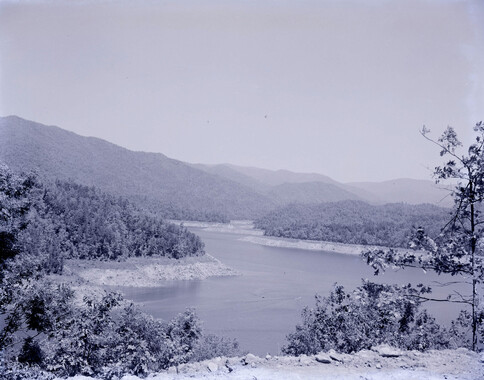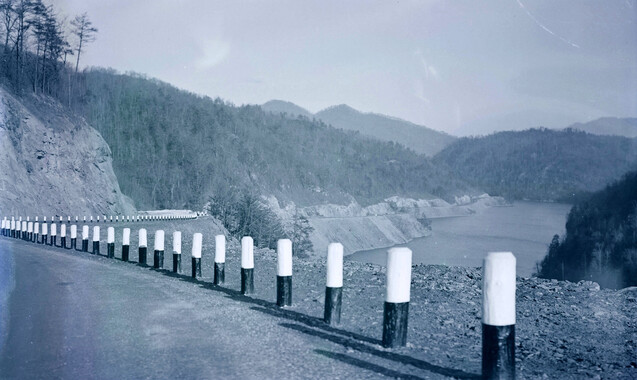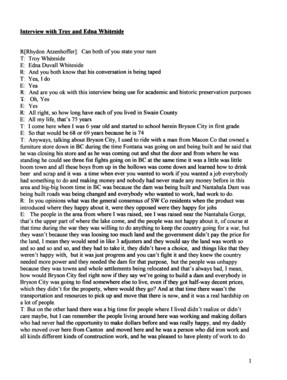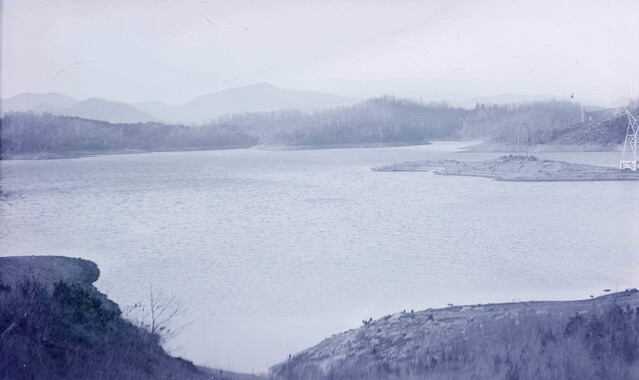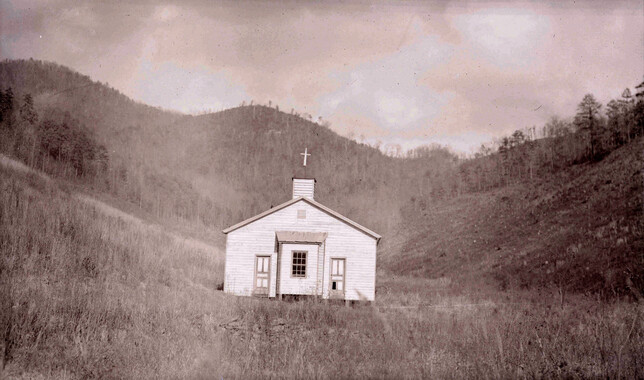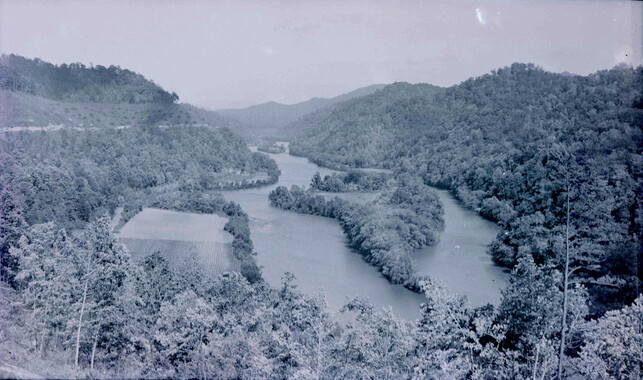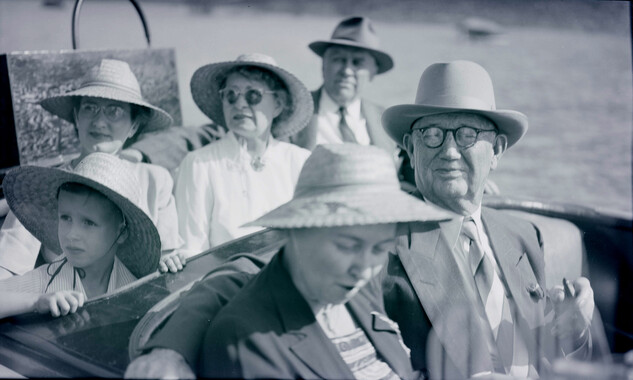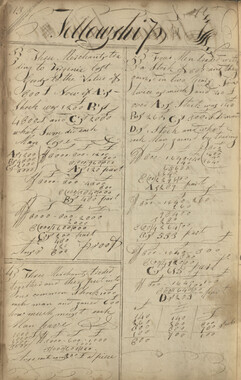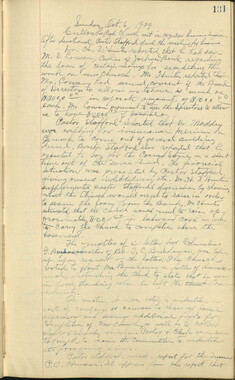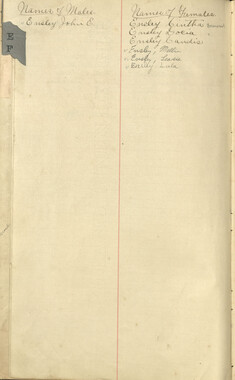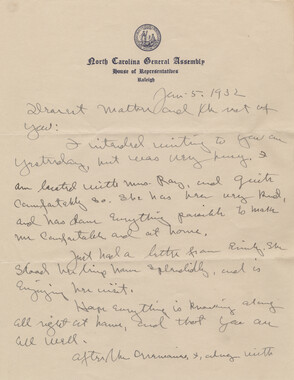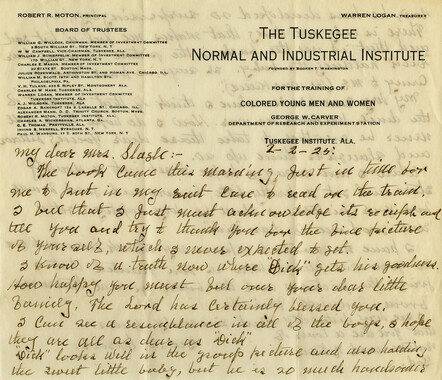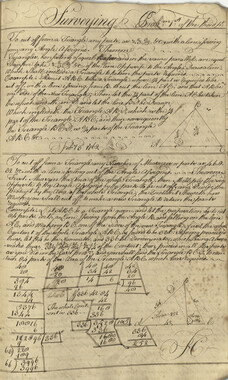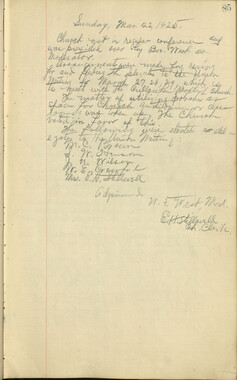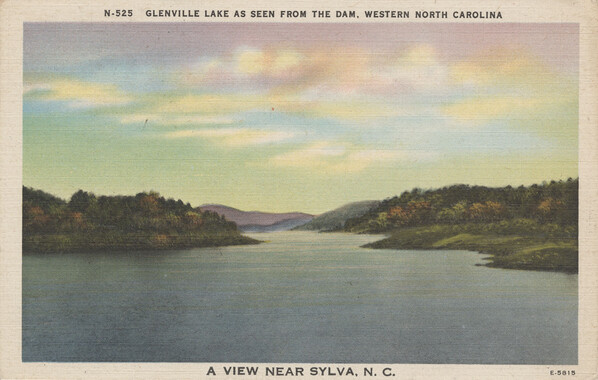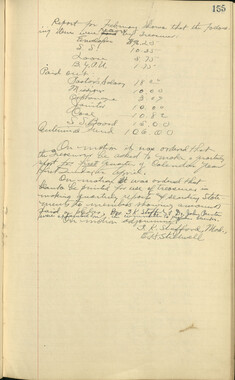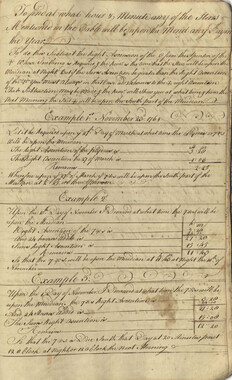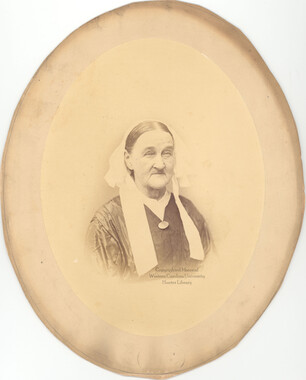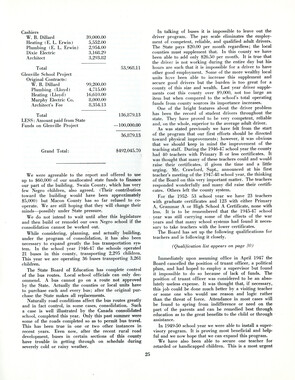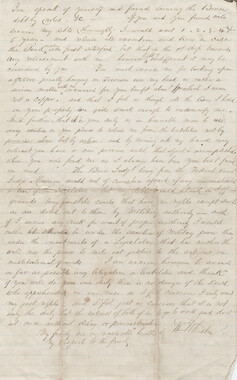Western Carolina University (6)
View all
- Highlights from Western Carolina University (2)
- Oral Histories of Western North Carolina (15)
- Picturing Appalachia (52)
- Stories of Mountain Folk (2)
- Travel Western North Carolina (2)
- Western Carolina University: Making Memories (1)
- Canton Champion Fibre Company (0)
- Cherokee Traditions (0)
- Civil War in Southern Appalachia (0)
- Craft Revival (0)
- Great Smoky Mountains - A Park for America (0)
- Horace Kephart (0)
- Journeys Through Jackson (0)
- LGBTQIA+ Archive of Jackson County (0)
- Western Carolina University Fine Art Museum Vitreograph Collection (0)
- Western Carolina University Herbarium (0)
- Western Carolina University Publications (0)
- Western Carolina University Restricted Electronic Theses and Dissertations (0)
- Western North Carolina Regional Maps (0)
- World War II in Southern Appalachia (0)
University of North Carolina Asheville (1)
View all
- Picturing Asheville and Western North Carolina (1)
- Faces of Asheville (0)
- Forestry in Western North Carolina (0)
- Grove Park Inn Photograph Collection (0)
- Isaiah Rice Photograph Collection (0)
- Morse Family Chimney Rock Park Collection (0)
- Bennett, Kelly, 1890-1974 (52)
- Allanstand Cottage Industries (0)
- Appalachian National Park Association (0)
- Berry, Walter (0)
- Brasstown Carvers (0)
- Cain, Doreyl Ammons (0)
- Carver, George Washington, 1864?-1943 (0)
- Cathey, Joseph, 1803-1874 (0)
- Champion Fibre Company (0)
- Champion Paper and Fibre Company (0)
- Cherokee Indian Fair Association (0)
- Cherokee Language Program (0)
- Crittenden, Lorraine (0)
- Crowe, Amanda (0)
- Edmonston, Thomas Benton, 1842-1907 (0)
- Ensley, A. L. (Abraham Lincoln), 1865-1948 (0)
- Fromer, Irving Rhodes, 1913-1994 (0)
- George Butz (BFS 1907) (0)
- Goodrich, Frances Louisa (0)
- Grant, George Alexander, 1891-1964 (0)
- Heard, Marian Gladys (0)
- Kephart, Calvin, 1883-1969 (0)
- Kephart, Horace, 1862-1931 (0)
- Kephart, Laura, 1862-1954 (0)
- Laney, Gideon Thomas, 1889-1976 (0)
- Masa, George, 1881-1933 (0)
- McElhinney, William Julian, 1896-1953 (0)
- Niggli, Josephina, 1910-1983 (0)
- North Carolina Park Commission (0)
- Osborne, Kezia Stradley (0)
- Owens, Samuel Robert, 1918-1995 (0)
- Penland Weavers and Potters (0)
- Rhodes, Judy (0)
- Roberts, Vivienne (0)
- Roth, Albert, 1890-1974 (0)
- Schenck, Carl Alwin, 1868-1955 (0)
- Sherrill's Photography Studio (0)
- Smith, Edward Clark (0)
- Southern Highland Handicraft Guild (0)
- Southern Highlanders, Inc. (0)
- Stalcup, Jesse Bryson (0)
- Stearns, I. K. (0)
- Thompson, James Edward, 1880-1976 (0)
- United States. Indian Arts and Crafts Board (0)
- USFS (0)
- Vance, Zebulon Baird, 1830-1894 (0)
- Weaver, Zebulon, 1872-1948 (0)
- Western Carolina College (0)
- Western Carolina Teachers College (0)
- Western Carolina University (0)
- Western Carolina University. Mountain Heritage Center (0)
- Whitman, Walt, 1819-1892 (0)
- Wilburn, Hiram Coleman, 1880-1967 (0)
- Williams, Isadora (0)
- 1920s (19)
- 1930s (17)
- 1940s (36)
- 1950s (2)
- 1600s (0)
- 1700s (0)
- 1800s (0)
- 1810s (0)
- 1820s (0)
- 1830s (0)
- 1840s (0)
- 1850s (0)
- 1860s (0)
- 1870s (0)
- 1880s (0)
- 1890s (0)
- 1900s (0)
- 1910s (0)
- 1960s (0)
- 1970s (0)
- 1980s (0)
- 1990s (0)
- 2000s (0)
- 2010s (0)
- 2020s (0)
- Appalachian Region, Southern (3)
- Graham County (N.C.) (17)
- Haywood County (N.C.) (1)
- Jackson County (N.C.) (2)
- Madison County (N.C.) (1)
- Swain County (N.C.) (60)
- Asheville (N.C.) (0)
- Avery County (N.C.) (0)
- Blount County (Tenn.) (0)
- Buncombe County (N.C.) (0)
- Cherokee County (N.C.) (0)
- Clay County (N.C.) (0)
- Great Smoky Mountains National Park (N.C. and Tenn.) (0)
- Henderson County (N.C.) (0)
- Knox County (Tenn.) (0)
- Knoxville (Tenn.) (0)
- Lake Santeetlah (N.C.) (0)
- Macon County (N.C.) (0)
- McDowell County (N.C.) (0)
- Mitchell County (N.C.) (0)
- Polk County (N.C.) (0)
- Qualla Boundary (0)
- Rutherford County (N.C.) (0)
- Transylvania County (N.C.) (0)
- Watauga County (N.C.) (0)
- Waynesville (N.C.) (0)
- Yancey County (N.C.) (0)
- Interviews (17)
- Manuscripts (documents) (2)
- Negatives (photographs) (52)
- Photographs (3)
- Portraits (5)
- Publications (documents) (2)
- Sound Recordings (17)
- Transcripts (1)
- Aerial Photographs (0)
- Aerial Views (0)
- Albums (books) (0)
- Articles (0)
- Artifacts (object Genre) (0)
- Bibliographies (0)
- Biography (general Genre) (0)
- Cards (information Artifacts) (0)
- Clippings (information Artifacts) (0)
- Crafts (art Genres) (0)
- Depictions (visual Works) (0)
- Design Drawings (0)
- Drawings (visual Works) (0)
- Envelopes (0)
- Facsimiles (reproductions) (0)
- Fiction (general Genre) (0)
- Financial Records (0)
- Fliers (printed Matter) (0)
- Glass Plate Negatives (0)
- Guidebooks (0)
- Internegatives (0)
- Land Surveys (0)
- Letters (correspondence) (0)
- Maps (documents) (0)
- Memorandums (0)
- Minutes (administrative Records) (0)
- Newsletters (0)
- Newspapers (0)
- Occupation Currency (0)
- Paintings (visual Works) (0)
- Pen And Ink Drawings (0)
- Periodicals (0)
- Personal Narratives (0)
- Plans (maps) (0)
- Poetry (0)
- Postcards (0)
- Programs (documents) (0)
- Questionnaires (0)
- Scrapbooks (0)
- Sheet Music (0)
- Slides (photographs) (0)
- Songs (musical Compositions) (0)
- Specimens (0)
- Speeches (documents) (0)
- Text Messages (0)
- Tintypes (photographs) (0)
- Video Recordings (physical Artifacts) (0)
- Vitreographs (0)
- Kelly Bennett Collection (52)
- Stories of Mountain Folk - Radio Programs (2)
- WCU Oral History Collection - Mountain People, Mountain Lives (1)
- A.L. Ensley Collection (0)
- Appalachian Industrial School Records (0)
- Appalachian National Park Association Records (0)
- Axley-Meroney Collection (0)
- Bayard Wootten Photograph Collection (0)
- Bethel Rural Community Organization Collection (0)
- Blumer Collection (0)
- C.W. Slagle Collection (0)
- Canton Area Historical Museum (0)
- Carlos C. Campbell Collection (0)
- Cataloochee History Project (0)
- Cherokee Studies Collection (0)
- Daisy Dame Photograph Album (0)
- Daniel Boone VI Collection (0)
- Doris Ulmann Photograph Collection (0)
- Elizabeth H. Lasley Collection (0)
- Elizabeth Woolworth Szold Fleharty Collection (0)
- Frank Fry Collection (0)
- George Masa Collection (0)
- Gideon Laney Collection (0)
- Hazel Scarborough Collection (0)
- Hiram C. Wilburn Papers (0)
- Historic Photographs Collection (0)
- Horace Kephart Collection (0)
- Humbard Collection (0)
- Hunter and Weaver Families Collection (0)
- I. D. Blumenthal Collection (0)
- Isadora Williams Collection (0)
- Jesse Bryson Stalcup Collection (0)
- Jim Thompson Collection (0)
- John B. Battle Collection (0)
- John C. Campbell Folk School Records (0)
- John Parris Collection (0)
- Judaculla Rock project (0)
- Love Family Papers (0)
- Major Wiley Parris Civil War Letters (0)
- Map Collection (0)
- McFee-Misemer Civil War Letters (0)
- Mountain Heritage Center Collection (0)
- Norburn - Robertson - Thomson Families Collection (0)
- Pauline Hood Collection (0)
- Pre-Guild Collection (0)
- Qualla Arts and Crafts Mutual Collection (0)
- R.A. Romanes Collection (0)
- Rosser H. Taylor Collection (0)
- Samuel Robert Owens Collection (0)
- Sara Madison Collection (0)
- Sherrill Studio Photo Collection (0)
- Smoky Mountains Hiking Club Collection (0)
- The Reporter, Western Carolina University (0)
- Venoy and Elizabeth Reed Collection (0)
- WCU Gender and Sexuality Oral History Project (0)
- WCU Mountain Heritage Center Oral Histories (0)
- WCU Students Newspapers Collection (0)
- Western North Carolina Tomorrow Black Oral History Project (0)
- William Williams Stringfield Collection (0)
- Zebulon Weaver Collection (0)
- African Americans (390)
- Appalachian Trail (35)
- Artisans (521)
- Cherokee art (84)
- Cherokee artists -- North Carolina (10)
- Cherokee language (21)
- Cherokee pottery (101)
- Cherokee women (208)
- Church buildings (170)
- Civilian Conservation Corps (U.S.) (110)
- College student newspapers and periodicals (1830)
- Dams (107)
- Dance (1023)
- Education (222)
- Floods (61)
- Folk music (1015)
- Forced removal, 1813-1903 (2)
- Forest conservation (220)
- Forests and forestry (1184)
- Gender nonconformity (4)
- Great Smoky Mountains National Park (N.C. and Tenn.) (181)
- Hunting (38)
- Landscape photography (25)
- Logging (118)
- Maps (83)
- Mines and mineral resources (8)
- North Carolina -- Maps (18)
- Paper industry (38)
- Postcards (255)
- Pottery (135)
- Railroad trains (71)
- Rural electrification -- North Carolina, Western (3)
- School integration -- Southern States (2)
- Segregation -- North Carolina, Western (5)
- Slavery (5)
- Sports (452)
- Storytelling (244)
- Waterfalls -- Great Smoky Mountains (N.C. and Tenn.) (66)
- Weaving -- Appalachian Region, Southern (280)
- Wood-carving -- Appalachian Region, Southern (328)
- World War, 1939-1945 (173)
- Sound (17)
- StillImage (56)
- Text (3)
- MovingImage (0)
Tennessee Valley Authority Reservoir Property Management Department Population Readjustment, Almond-Judson Community Fontana Area
-
This report, entitled “Almond-Judson Community, Fontana Area,” was completed in 1944 by Mr. Arnold James Hyde (1914-2010) for the Tennessee Valley Authority (TVA). Hyde was employed by the TVA to assist in the acquisition of land and relocation of residents in Graham and Swain County to make way for the Fontana Dam hydroelectric project. This report focuses on the Almond and Judson and includes the communities of Wesser, Stephenson Branch, Turkey Branch, Alarka Creek, and Grassy Branch. The report contains descriptions of the topography, history and settlement, roads, businesses, schools, and churches, demographic data, and original photographs. Hyde was born in Graham County, NC, graduated from Robbinsville High School, and then later from Western Carolina Teachers College (Western Carolina University). He married Dorothy Roberts, of Buncombe County, NC, in 1943, and they had two daughters.
-
-
TENNESSEE VALLEY AUTHORITY Reservoir Propert;<" Mmage:11ent Department Population Readjustment Ll10ND-JUDSON COr.ft.ruNITY FONT.A.NA PJ1EA. Prepared by .fu:•nold J. Hyde This Report For Use Within TVA Only Not for Publication June 1, 1944 To: From: Date: Subject: Hr. W. T. Hunt, Principal opulation Readjustment Repr esenta ti ve Arnold J. Hyde, Senior Population Readjustment Worker June 1, 1944 ALl10ND-JUDSON COl1MUNITY - FONTANA RESIRVOIR I am submitting herewith a copy of a study made of the Almond-Judson community. In this study, an attemot has been made to analyze the Eocial and economical phases of the life of the community and to determine, as far as possible, how this community, together with the adjacent neighborhoods, will be affected by the creation of the :fontana Reservoir. The material used in this study was taken larr-ely from the case records of those families living in the reservoir and vith whom this office has worked. The study was prepared before evacuation was corrplete; therefore, it has been impossible to include information which would indicate tenure status after removal. It is hoped that this otudy give enough of the hstory and background of this community and sufficient facts to €nable one who reads it to get a rather good picture of the conditions which existed within the community prior to the time of evacuation. Arnold J. Hyde I A1"10ND-JUDSON COMMUNITY Scope of Study The territory included in this study is divided into several neighborhoods extending along Little Tennessee River from Hesser to Bushnell, covering an area approximately fifteen miles long and varying in width from a few hundred feet to three or four miles. Judson and Almond, the largest neighborhoods, will be entirely flooded. The neighborhoods of Wesser, Stephenson Branch, Turkey Branch, Alarka Creek, and Grassy Branch will be only partially flooded. The Almond-Judson community is located in the western part of Swain County approximately tbree miles from the Graham County line and ten miles west of Bryson City. It is served by former highway # 19, a state-maintained, hard-surfaced road. The main road from Asheville to Murphy extended through the village of Almond prior to its relocation above the 1723' contour several years ago. The officials of the Nantahala Power and Light Company, anticipating the building of Fontana Dam, used their influence in getting the highway relocated outside the Fontana Basin. Topography and Scenic Attractions This is an extremely mountanious area. Slopes leading from the Little Tennessee River are decidely steep with occasional narrow tracts of intervening bottom land. Almond and Judson are located on a narrow bench approximately one-quarter of a mile in width near the junction of Nantahala and Little Tennessee Rivers. This region is noted for its scenic beauty and attractions. Overlooking it from the northeast are the majestic Great Smoky Mountains, and on the southwest is the deep and beautiful Nantahala Gorge. In addition to an abundance of hardwood and evergreen trees, which cover the mountains, there is also a variety of flowering shrubs and smaller plants. Blossoming dogwood, azalea, rhododendron, and mountain laurel grow here in profu ion. Clear, sparkling streams wind their way through deep ravines and over the sharp cliffs to the vaJ.leys below, enhancing the natural beauty of the immediate surroundings. To sightseers, tourists, and sportsmen, this region is unexcelled, but the land is too rough to be of much value for agricultural purposes. Historical Background This area has long been the home oft e Cherokee Indians. Mmy Indians were living in t:his region at the time of DeSoto•s expedition through western North Carolina. The famous Cherokee chief, Euchella, ma e his home near the village of Almond in Fuchella Cove. In about the year 1750, the first white people settled among the lndians. 'I'hese early pioneers belonged to an independent, hardy class of people, most of whom were of Scotch, lriPh, end English descent. They came to North Carolina from stc1tes 1'artrer north and drifted across the Flue Ridpe Mountair:,s .rrom the easter::1 nart of t.he State. One of the nrst large land ow E:rs of the Almond-Judson community was Colonel Thad Siler, who lived near the mouth of antahala J. iver. He sold a large boundary to N. O. lrnond, from whom the village of 10nd ua.s named. ior to the War between the States, a fort was constructed on a hill overlooking 11J.mond. It was used £'or protection from the Indians and was manned during the Civil 1lar as a precaution in the event the enemy attempted to marc:1 through this section. 2 The Urnond-Judson comm.unity, like Bushnell, first became prominent as a 11standn, provjding accommodations for cattlemen who stopped overnight e11route from Ten..nessee. With the completion of the railroad about 1880, the community became the center of the lumber industry of Swain, Graham, and ffacon Counties. The great variety of virgin timber attracted outside capital. A mushroom town of approximately one hundred fifty families sprang up in Judson. A spur railway track was built into Graham County, and an area of several square miles was stripped of its virgin timber. The lumber company moved on to new territory, leaving many families stranded with no means of livelihood other than meager agricultural activities. Appro:xinately twenty years ago, the Nantahala Powex and Light Company began purchasing land in the Fontana basin contemplating the construction of Fontana Dam. any families sold their property and moved out. Some sold and then rented, becoming tenants of the Power Company. A few remaining land 01.mers, who refused to sell, endeavored to keep the community spirit alive. The progress of the community has apparently been retarded by the wide-spread belief the.t Fontana Dam would eventually ·e constructed. These Power Company tenants and the remaining mmers of Judson and Almond are now being moved because of the construction of the dam by T V A. People There is a total of one hundred sixty-six families within the community who will be directly affected by the building of Fontana Dam. Of this number, one hundred forty-three are oricinal families and twenty-three transients. The o:::-iginal families are of native stock. The pioneers lived fo:;, many years practically isolated from the rest of the world, clofied in betl!een the Nantahala and Smoky 3 lountain Ranges. Only a thrifty race could have survived the many hardships encountered prior to the building of the railroad in 1885. The people are friendly, congenial, and, as a rule, religious, hard-working, and law-abiding. The standard of living varies considerably. Families living in the villages of Judson and Almond are progresive and make a fair living, but a majority of those in the more isolated regions are existing in a state of poverty. The farm homes, a.s a rule, are in a poor state of repair and a:ce furnished with bare necessities. The boxed and frame houses are the two common types of dwellings; although, many log cabins remain in the more isolated neighborhoods. Host homes are lighted by means of kerosene lamps; however, five families have shown their ingenuity by producing their own electricity from water-powered plants. Less t:han five per cent of the homes have running water. The open spring is the principal source of water supply. Outdoor toilets are generally used, and often these are placed over streams, thus contaminating t _ e water. The people are not inclined to move from place to place. pproxiil:ately thirty-three per cent of the original families have lived in this cormmmity during their entire lives. The study shows that the average original family has L..6 members; however, this is not a true picture, as children in the armed forces and members employed m-ray from home vere not included in the study. It is interesting to note that in recent years, the mountaineers have become extremely conscious of the advantages of an education. Considering the fact that many children had to 1alk a long distance over torturous trails to and from schools, it is unusual to find that of a total of one hunc!red eighty-nine children of school age, one hunc.red seventy-seven attended school a portion of the 1941- 1942 school yoor. Illiteracy among the narents is lower than t e state average ! Of a total of one hundred sixty-six members recorded as a head or a family, only four could not read or urite. The average grade reached is a little better tl:.an the se,·enth. Ten attended college, six or whom hold Bachelor or Science degrees. Former u. S. Highway 11/= 19 traverses tJ,,e community for a distPnce of approxiraately eight miles. gravel road extends from Graham County by wc.y of Judson and intersects U. S. i;' 19 near c.. tterson Springs. The county type roads up the many streams nnd :101lows are rough and almost impassable during bad weather. narrow, winding, dirt road was constructed uit _ UP.A labor from Judson to Bryson City by way of Round Hill community. The Southern Railway runs parallel with the Ll.ttle Tennessee River through the entire 4 length of the community from Bushnell to Wesser. Thif' track is eing relocated fr om Bryson City to Vesser, a distance of approxima tely sixteen miles. The mileage of . ighwa,·s to be relocated in this community by the Authority is more than the combined mi leage of the highways in all the other co:mmuni ties of the res ervoir. Former U. S. High ·way # 19 tdll be submerged from Alnrka Creek to Siles Branch, a distance of approximately six miles. The present plans of the Aut _ori ty are to construct a uavel road from Graham County by way o Almond, intersecting U. S. 1¥ 19 at Siles Branc - • Thi s road wi ll give access to the neighborhoods of Watia end Turkey Branch, as well as all families livine abo e the 1723 ' contour in the Panther eek section of Graham County. An access road is to be constructed from Alark.a Creek by 1,my of Grassy Branch to Stephenson Branch, uhich will give an outlet to approximat ely twenty families livinq above contour in this area. It will be necessary to construct several miles of t ertiary roads to the homes of scatter ed L·aruilies livin? throughout th o conm1unity abo e pool level, because their present access will be sever ed by the impoundage of water from Fontana Dam. Trade Ar ea There are eight sma.11 grocery and eeneral merchandise stores located in the Almond-Judson community within the taking line. This community, how ever, draws a large trade from adj acent neighborhoods not included in the study and from the Stecoah and fanther Creek sections in Graham County. JVany farmers do their trading in l::lryson City, where a wider variety of foods and farm supplies can be found . Two stores loc'.lted above tLe 1723 ' contour at Wess er vriJ l be indirectly affected by loss of trade ; although, neith er will have to be relocated . Several famiB es B.ving in the Watia neigh orhood, who in the past patronized these stores, will be given access by way of Almond, eliminating ess er as their trading center. Crops The principal crops erown in the community are corn , Irish potatoes, tobacco, hay, and veg etables . Farmers receive more cash from the sale of timber prod cts , namely, pulp wood, acid wood , lumber, and tan bark, tr.an all other agricultural products combined. Burl ey tobacco, however, had recently been introduced into this region, and upon the exhaustfon of the timber, is considered the potential cash crop for Swain County . Cattle are grown throughout the community but in comparatively small numbers . A vast majority of the families grow vegetables and produce milk and butter for home consumption . Connnunitv . ctivities The principal social activities of the connrruni ty cent er arotnd the church and schools with various young peopl e ' s organizations , athletic programs, and parent teachEX associations . The old time singing convention is an annual event attended by families from the most remote sections, who bring picnic lunches and spend the day enjoying the music of the competing choirs. In recent years, many of the farm fanili es have b ecom e extr er1 ely int er es t ed in the progrmn spons ored by t _e County Farm Agents 1dth the various s ewing and cooking clubs for the wom Pn , pr ogram for the m en , and 4-H 5 clu s for the youne p eopl e . Bryson City , the n ear es t town , fllrnishes much of the s o cial and r ecr eational life in the form of thea t er s , lodges , and county-wi d e pr ograms . S c hools Almond , a c entraliz ed high and elementary s chool , will be the only educational ins titution in the c ommunity entir e y submerged by the ba ckwat ers of Fontana Dam. Two one-t ea cher elementary s chools will be indir ectly a ffect ed . The Almond s chool buildine is a larre two-story brick s tructur e in fair conditi on . Gymna s ium and luncbroom buildinrs i1er e r ec ently conv er t ed into cla s s r ooms . The enrollment in 1941 was appr o::·imat ely four hundr ed .t.:.c- s chool and el ementary pupils inclusive . Ov er two }mndr ed of this number wer e trans port ed by bus from tl1e various n eighborhoods . The pr er ent plans of the 0wain C ounty s chool officials ar e t o r eloca t e an el nentary s chool in the Lauada community appr oximat ely s ix rn:iles west of Bryson City . The r emaining high s chool pupils above pool el evation now att ending Umond s chool wil l be transpor t ed to Bryson City . Ther e is e. pos dbjlity that the small one-teacher s c hool in the :fa t ia con:D"lunity wil l be dis continued, ina smuch as the Authority i s to construct a road to the n eie-hborhood , whi ch ID.11 enable the stud ents to b e transport ed t o the Lauada s choo l . The pr e s ent r oad i s too r ourh and dangerous for a s chool bus r out e , which neces s itated the operating of a s eparat e s chool within commutabl e distance of the cons olidat ed s chool at lmond . The enr ollment of the Round Ifill elementary s chool will evid ently b e incr ea s ed , a s many of the r emaining pupils above the lake l evel in the Fistrap Branch and Grassy Branch neighborhoods who former ly att ended Almond s chool will be r equir ed to att end this s chool . Chur ches The community is pr edominantly Baptist . A total of thr ee a ctive Baptist chur ches ar e loca t ed within the ar ea below the pr opos ed taking line . Thes e ar e the Almond Baptist Chur ch, Judson Bapti st Chur ch, and the Ht . Zion Baptist Chur ch. :..n old abandoned Methodi st Chur ch building at Jud son s erves as a s tark r emind er o f the mor e progr es sive days when Hethodists lived and wors hipped among the native Baptists . The Baptist Chur ch of Jat ia n eighborhood above pool will suffer s ome lost'. of member ship . Jtany of the memb ers l ive on the opnos i t e s i d e of the river from the church building . The a c c es s r oa d to b e built by the Author ity will cr o s s the r iver approximat ely two miles below, thereby making continued att endance inconveni ent . The Almond B nd Juds on Bapt:i.st Chur ches will pr oba bly b e di s solv ed , but the Ht . Zion Chur ch will b e r elocat ed above the taking lin e and will continu e to s erve the Gra s sy Branch and St ephenson Branch n ei ghborhoods Hith a s l _ght loss of membership . Hany of the far:tl] i es l iving in the Gra s sy Branch and Fishtrap Branch n eighborhoods a bove contour who :former ly attended chur ch at Jud son will find it vcry inconvenient to att end any place of wor :.:-hi p . The n earest chux·ch is in the Round Hill community , a distance of appr oximat ely six mil es across the mountains . Employment and Income Less than 30 p er c ent of the famili es studi ed r ec eived a maj or part of their income from agricultural sources . Many of these were forced to supplement th.is income by working at various odd jobs during the non-farm season . The fact that of 177 members of original famili es gainfully employ ed, 51 wer e working on WP , CCC, and NYA, and 13 r eceiving public assistance , r efl ects something of the economic conditions of the commu..ni ty in 1941 . Thirty orj_ginal and 19 transi ent members of r eservoir families wer e employed on TVA. A majority of thes e had been employed on the Hiwassee Pr oj ects in the vicinity of Murphy, North Carolina , prior to the b eginning of the construction of Fontana Dam. It is interesting to not e that by the end of 19L.3, &ilployees of the .Authority had increas ed to 89 . Ther e ar e no industries locat ed ·within a reasonabl e distance of the coillillUnity . Only 3 memb ers of r es exvoir farrdli es wer e classified as industrial ·workers . Thes e were employed by the Carolina Woodturning · company at Bryson City . The average income of original farm families in 1941 was 4?8 , while that 01' non-farm famili es was ".'999 . In r eality , this is not a tru e comparison of the economic conditions of the two groups , a s the valu e of food consumed at home by the farm fami1i es was not included as income . The average income of the 23 transi ent f'amilies was '.1612 . Nineteen of thes e wer e employed on TVA, 3 were school teachers , and 1 worked on WP • These facts indicate that employment in the community is highly diversified ; that it is n either agricultural nor industrial , but is a combination of the many various lin es of end eavor . .Probabl e Effects on the Conn.nunity: Almond and Judson will b e entir ely inundated, thereby losing its identity . The r emaining scattered families living above contour will undergo maj or r eadj ustment problems . The school will be r elocated in the Iauada commu..,.ity. Two churches \rill b e dissolv ed and one r eloca t ed abov e pool el evation . Bryson City , the near est tradint: center , \!ill b e v ery inconv eni ent for thos e famili es who have no modern means of transportation . The loss of the f ertil e bottom land , even though the acreage is small , will caus e radical changes in agricultural methods . The extremely rugged nature of the adjac ent lands makes 6 it impos sible for farm famili es to r e-establish homes on the steep , unpr oductive land above the r es ervoir margin . A larg e pr ecenta g e o f the 143 original famili es affect ed will b e for c ed to r elocat e in another community, many of whom will move to adj o inig counti es . The flooding of the t imber lands will have no s erious effect on the pulp vood and lumber industry . Over 90 per c ent of the ar ea to b e covered by wat er in this community has been s tr ipped of its commer cial timber . Follow-Up Suggestions Due to the lar g e acr ea g e in Swain County now in Government ownership or s cheduled to b e a cquir ed , the who l e economic structur e of the County wil l ultimat ely und ergo c ertain changes . The a cuisition program for Fontana Dam alone will total nearly 60, 000 a cr es , of which appr oximately 40, 000 will b e transferr ed to the Gr eat Smoky Mountains National Park . The Park, the Cherokee Indian Res ervation, and the Nantahala National For est alr eady own substantial acr eage. Two r esults growing out of the a cqui sition program may be anti cipat ed ; (1 ) A cer-tain amount of crowding back of famili es on the st eep ridg es outside the Res ervoj_r Ar ea , (2 ) A cons i d erable loss of famili es to the County by r ea s on of a s car city of privat ely-owned land . Extension Servi c e expects to continue to work with thes e famJ li es , especially farm families , until their r eadjustment j_ s compl ete in the n ew location. The economic importance of the ark , the Cher okee Indian Res erva tion , and the Natj_onal :forest , together with Fontana Lake 7 uhen complet e, is not fully appr eciat ed a s yet by the p eople of Swain County . Car eful planning can and pro ba bly will d ev elop this ar ea into a ha • en for tourists . The County has every natural r esom· ce n e ed ed . Rec ently , ·with as sistan c e of t12e Regional St" di es Department of TVA, a county Plannine; Commi s sion wa s esta blis h ed . Some thought has b een given to ar eas availabl e for or suita bl e for r ecr eational d evelop1:1ent . The Commiss ion needs exp ert adVi c e on things that can be done, on how they can be don e , and , most im· ortant , some s timulus to put a pr oe-ram into a ction . S'!.' .• TTST I C .L '.!'ABI:ES CONCffiNIN G RFSE."ltVOIR F IILIES IN THE I1 !0ND-JUDS0N CGrJNill:ITY 8 TABLE I Reservoir Families According to Tenure, Farm Status, and Residen ce Original Families 1"ransient Families Total Families Owner Families Tenant Families Non-Farm Farm Non-Farm 18 0 18 16 0 16 31 0 3 1 78 2 3 101 9 Total Families 143 23 166 10 TA,'JLE I I Numb er of years Or iginal Famili es Have Lived in Community Original Years in Community Fami 1 i es Less than 1 year 9 1-5 y ears 22 6-10 year s 2 0 "-----" 11-20 years 23 2 1-3 0 years 12 31-40 years 7 41-65 years 3 Life ..KL Total Families 143 Years at :r es ent Less tban 1 y ear 1-5 years 6-10 years 11-20 years 21-3 0 y ears 31-40 years 41-65 y ears Life Numb er of Years Original Fam:i.lies_ Have Lived at Pr esent Site Sit e Total Fami li es 11 Original Families 30 47 22 19 13 6 2 Jr 143 12 TABLE IV Numb ers of Memb ers in Res ervoir Families Original Transient Total 1 Member in Family 4 0 4 2 Members in Family 17 2 19 3 II It II 31 4 35 4 rt 11 It 33 5 38 5 II It II 15 4 19 6 ti II It 18 4 22 7 ti It It· 11 1 12 8 ti If ti 6 1 7 9 If It II 3 2 5 11 It It fl 3 0 3 12 n " II 1 0 1 15 n II II 1 0 1 Total Families 143 23 166 \..., 13 T.ABLE V Record of School Children in Res ervoir Families Original Transient Total No . of Children of School Age 160 29 189 No . of Children in School 149 28 177 No . of Children of School Age But not attending School 11 1 12 14 ' TABLE V I Highest Grade Reached by Head of Family Original Transi ent TotaJ:. No Education 4 0 4 First Grade 1 0 1 Second Grade .3 1 4 Third Grade 11 4 15 Fourth Grade 1.3 0 1.3 Fifth Grade 16 1 17 Sixth Grade 16 1 17 Seventh Grade 41 6 47 Eighth Grade 18 3 2 1 Nin eth Grade 7 1 8 T enth Grade 2 2 4 Eleventh Grade 5 0 5 College One Year 0 0 0 Two Years .3 1 4 Three Y ears 0 0 0 Four Years 6 Total 143 23 166 --- Owner Farmer Own er Non-Farmer T enant Farmer Tenant Non-Farmer Total Number of Famili es 18 16 31 78 143 TABLE VII Income For 1941 - Original Famili es TOTAL OF INCOME FROM u blic Farm Non-Farm Assistanc e i5 , 784 . 00 pl, 870. 00 ,1, 533 . 00 1. 100. 00 16, 225 . 00 596 . oo 7 , 645 . 00 3 , 480 . 00 2 , 695 . 00 3 00 . 00 63 , 766 . 00 4 , 486 . 00 $14, 829 . 00 t85 , 341 . 00 '$9, 310 . 00 Total Income for Original Families in 19L,l -- ;>109, 480. 00 ---------•---·------------------- Average Income _ Fr9m Farm t321 .33 68 . 75 246 . 61 3 .46 i' 640 . 15 h.verage Jncome Fro All 2our c es ( 510 .39 1, 12 0 .. 06 445 . 81 878 . 8 7 ,2 , 95 5 . 13 I-' V't T BLE VII Income For 1941 - Transi ent Families Tenur e Tenant Non-farmer Number of Famili es Farm Non-Farm 23 t935 . 00 35, 809 . 00 Public Assistan c e $350. 00 Total income for transi ent famili es in 1941 -- tJ7, 094. 00 Average income for transient famili es in 1941 -- $1, 612 . 78 4 famili es r eport ed s om e income from farm -- average income -- i243. 77 -- $' 350. 00 16 1 fami ly r ec eived Public s sistan ce verage non-farm income -- $1, 5 5 6.91 rillag of .:"uds on Residen c e of an author R esidence of farm family On e of the most productive farms in reservoir One of the bett er farm homes in reservoir One of the poorer farm homes in r €s ervoir .., A former lumber company boarding house now owned by reservoir family New home of the family .. t· Almond School Former Gymna sium and lunchroom at Almond School now used as classrooms , • . I . Store near _ lmond on Pmver Company land Grist mill in res ervoir Highway bridge constructed by TVA near Almond Depot and abandoned br idge at ALond Construction of railroad on Little Tennessee River Construction near village of Almond Home of prominent res ervoir family New home of family Governor ' s Island Vall ey near Bryson City into Hhich four families r elocated New home o: res ervoir fa!lLi.ly !fop farm of r es ervoir family Fi €ld on above farm C,,mer ha d little :'arm lan , in r cs n·voir !Jantahala Gorge Scene in ree ervoir




